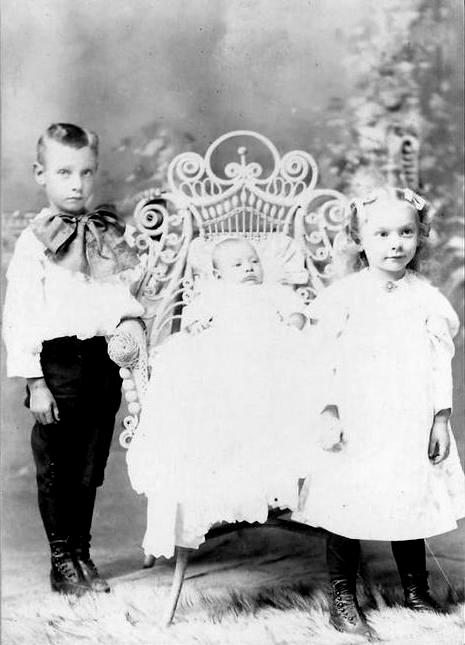
Blouses: Gender Trends

Figure 1.--This cabinet portrait is of three unidentified American children. Notice that the boy wears a white blouse and floppy bow while his little sister wears a dress. The stuydio was Hansen in Hampton. Iowa. It is undated, but we would guess was taken in the very-late 1890s or 1900s. Note the white whicker.
|
|
The blouse today is seen a primarily a girls'/woman's garment. Blouses in the 19th century like shirts were primarily a male garment. Most 19th century portraits showed girls wearing dresses. We do not begin to see portraits of girls wearing blouses until the late 19th century, but they seem much less common than girls wearing dresses. We do not know a great deal about girls' clothing and we are not sure just when girls began wearing blouses and skirts rather than just dresses. Unfortunately we do not knoew as much sabout girls' cloyhing as boys clothing. Nor are we sure just why this chasnge occurred. The skirt and time line seems identical and related to that of the blouse. Boys continued to wear blouses into the 20th century. This began to change after World War I (1914-18). Boys wanted to wear shirts rater blouses. We even note boys objecting to their shirts being called blouses. Gradually only pre-school or very young blouses wore blouses, often for dress up occassions. The blouse and skirt became major garments for girls. Here the time line varied from country to country top country, but the basic trend occurred throughout Europe and North America.
HBC

Navigate the Boys' Historical Clothing Web Site:
[Return to the Main blouse page]
[Introduction]
[Activities]
[Biographies]
[Chronology]
[Cloth and textiles]
[Clothing styles]
[Countries]
[Topics]
[Bibliographies]
[Contributions]
[FAQs]
[Glossaries]
[Images]
[Links]
[Registration]
[Tools]
[Boys' Clothing Home]
Created: 2:53 AM 7/25/2009
Last updated: 2:53 AM 7/25/2009



